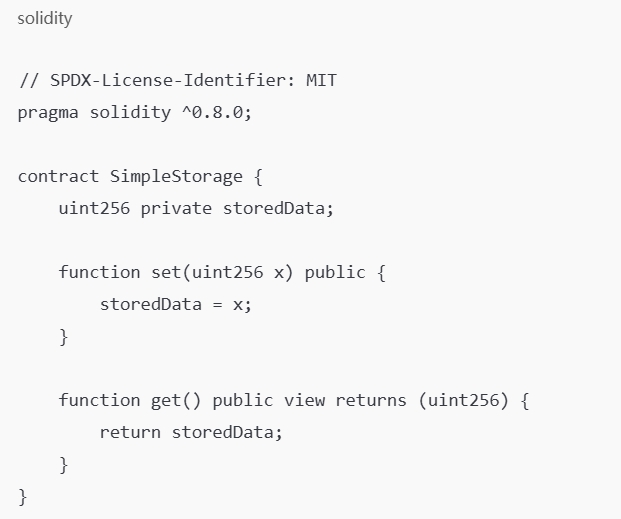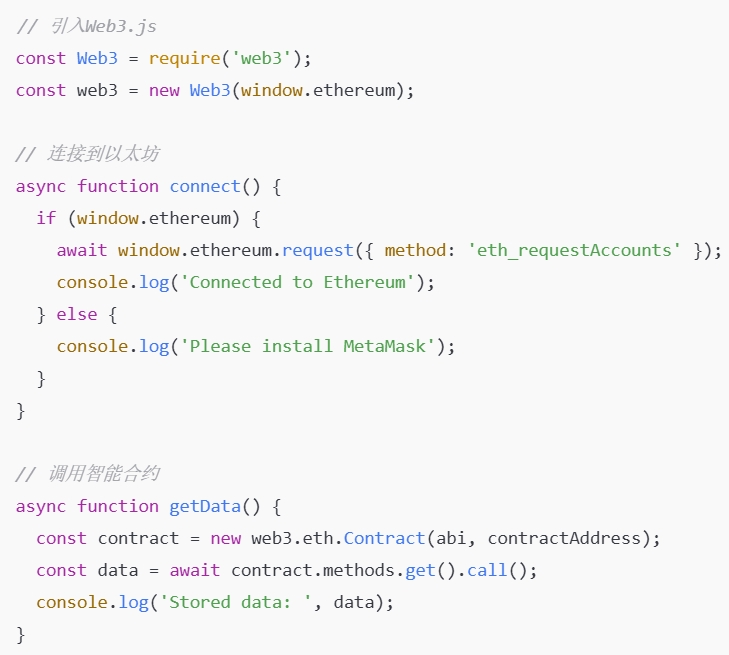Getting Started with DApp Development: How to Build a Decentralized Application
- latest articles
- 1.DApp Development & Customization: Merging Diverse Market Needs with User Experience 2.Analysis of the Core Technical System in DApp Project Development 3.How to achieve cross-chain interoperability in Web3 projects? 4.How does the tokenization of points reconstruct the e-commerce ecosystem? 5.How to Set and Track Data Metrics for a Points Mall? 6.What is DApp Development? Core Concepts and Technical Analysis 7.Inventory of commonly used Web3 development tools and usage tips 8.Development of a Distribution System Integrated with Social E-commerce 9.Six Key Steps for Businesses to Build a Points Mall System 10.What is DApp Development? A Comprehensive Guide from Concept to Implementation
- Popular Articles
- 1.Future Trends and Technology Predictions for APP Development in 2025 2.Analysis of the DeFi Ecosystem: How Developers Can Participate in Decentralized Finance Innovation 3.From Zero to One: How PI Mall Revolutionizes the Traditional E-commerce Model 4.DAPP Development | Best Practices for Professional Customization and Rapid Launch 5.Recommended by the Web3 developer community: the most noteworthy forums and resources 6.From Cloud Computing to Computing Power Leasing: Building a Flexible and Scalable Computing Resource Platform 7.How to Develop a Successful Douyin Mini Program: Technical Architecture and Best Practices 8.Shared Bike System APP: The Convenient Choice in the Era of Smart Travel 9.How to Create a Successful Dating App: From Needs Analysis to User Experience Design 10.From Design to Development: The Complete Process of Bringing an APP Idea to Life
With the continuous development of blockchain technology, decentralized applications (DApps) have gradually become a focal point in the field of emerging technologies. DApps are not just a technological innovation; they also represent a completely new network architecture and application development model. In a decentralized network, users can directly interact with smart contracts without relying on traditional central servers or intermediary platforms, thereby ensuring data security, transparency, and immutability.
This article will delve into how to build a decentralized application, introducing the basic concepts, working principles, development tools, and the actual development process of DApps. Through this article, readers will gain a comprehensive understanding of DApp development and acquire the basic skills to build their own decentralized applications.
1. What is a DApp?
DApp stands for Decentralized Application, referring to applications built on the foundation of blockchain technology. Unlike traditional applications, DApps do not rely on central servers but instead achieve decentralized functionality through distributed networks and smart contracts. The core characteristics of decentralized applications include:
Decentralized Data Storage: Data is stored on the blockchain network rather than on traditional central servers.
Smart Contracts: Smart contracts are automated contract execution mechanisms that automatically perform predefined operations when specific conditions are met.
Open Source Code: Most DApps are open source, allowing anyone to view, modify, and contribute to the code.
Encryption Security: Due to the immutable nature of blockchain, DApp operations and data are secure and cannot be altered or interfered with by third parties.
These characteristics give DApps significant potential in many fields, especially in finance, social networking, gaming, and supply chain management.
2. How DApps Work
The core of DApps relies on blockchain technology. Specifically, DApps typically consist of the following main components:
Frontend Interface: The frontend of a DApp is usually a web application written in HTML, CSS, and JavaScript, through which users interact with the DApp via a browser.
Smart Contracts: Smart contracts are programs that run on the blockchain, used to execute predefined conditions and operations. They are typically written in programming languages like Solidity and deployed to the blockchain.
Decentralized Storage: Although smart contract data can be stored on the blockchain, the storage space on the blockchain is limited. Therefore, DApps often use decentralized storage solutions, such as IPFS (InterPlanetary File System), to store large amounts of data.
Blockchain Network: DApps interact with smart contracts through the blockchain network. Currently, Ethereum is one of the most popular blockchain platforms because it offers robust smart contract functionality and extensive development tool support.
User Identity and Security: Users typically manage their identities and crypto assets through digital wallets. Wallets like MetaMask help users manage interactions with the blockchain while providing features such as signing to ensure transaction security.
3. Steps to Build a DApp
1. Choose a Suitable Blockchain Platform
The first step in building a DApp is to choose a suitable blockchain platform. Currently, the most popular blockchain platform is Ethereum, which supports smart contracts and decentralized application development. Additionally, there are other blockchain platforms suitable for DApp development, such as:
Ethereum: The most popular platform currently, supporting smart contracts and DApp development, with rich development tools and documentation.
Polkadot: A multi-chain platform designed to achieve interoperability between different blockchains.
Solana: Known for its high performance and low transaction fees, suitable for DApps requiring high throughput.
Binance Smart Chain (BSC): A blockchain platform launched by Binance, compatible with the Ethereum Virtual Machine (EVM), offering faster transaction speeds and lower fees.
When choosing a blockchain platform, it is necessary to weigh factors such as transaction speed, transaction fees, and community support based on the specific needs of the DApp.
2. Write Smart Contracts
Smart contracts are the core of a DApp, and all decentralized business logic is implemented through them. Taking Ethereum as an example, smart contracts are typically written in the Solidity programming language. When writing smart contracts, the following aspects need to be considered:
Contract Functionality: Smart contracts need to implement the core functions of the DApp, such as transfers between users, data storage, and permission control.
Contract Security: Smart contracts are immutable, so they must undergo rigorous security audits before release to prevent vulnerabilities from being exploited maliciously.
Gas Fees: Transactions on the Ethereum network require payment of Gas fees, so Gas optimization must be considered when designing smart contracts.
Below is a simple example of a Solidity smart contract:

In this example, the SimpleStorage smart contract allows users to store and retrieve a uint256 type of data.
3. Deploy Smart Contracts
After writing the smart contract, it needs to be deployed to the blockchain. Taking Ethereum as an example, the steps to deploy a smart contract are typically as follows:
Use development tools like Remix IDE to write and test the smart contract.
Use frameworks like Truffle or Hardhat for local development and testing.
Deploy the contract to the Ethereum mainnet or testnets (such as Rinkeby or Ropsten).
Use wallets like MetaMask to manage keys and Gas fees during the deployment process.
4. Develop the Frontend Application
The frontend part of a DApp is similar to traditional web applications, developed using technologies like HTML, CSS, and JavaScript. However, the DApp frontend needs to interact with the blockchain through libraries like Web3.js or Ethers.js. Using these libraries, the frontend application can call smart contracts, initiate transactions, and query on-chain data.
Below is a simple example of frontend interaction with a smart contract:
5. Testing and Optimization
Testing is a crucial part of the DApp development process. Developers need to conduct multiple tests, including:
Unit Testing: Testing each function and logic in the smart contract.
Integration Testing: Testing the interaction between the frontend and the smart contract.
Performance Testing: Testing the DApp's performance under high concurrency scenarios.
Additionally, the performance and user experience of the DApp need continuous optimization to ensure users can operate smoothly, avoiding high transaction fees and network delays.
6. Deployment and Release
Finally, once the DApp is developed and thoroughly tested, it can be deployed to the production environment. This typically includes:
Deploying the frontend code to a server or IPFS.
Deploying the smart contract to the mainnet and ensuring the contract address and ABI are correct.
Ensuring that wallet and identity management functions operate normally, allowing users to conduct transactions and interactions smoothly.
4. Challenges and Future of DApps
Although DApps have advantages in decentralization, security, and transparency, they still face some challenges:
Performance Bottlenecks: The throughput of blockchains is relatively low, and DApp performance may be affected, especially under high concurrency.
User Experience: Compared to traditional web applications, DApps have a higher barrier to entry, as users need to understand concepts like digital wallets and Gas fees.
Legal Compliance: Since DApps do not rely on central management, many countries and regions have not fully adapted their legal systems to this emerging technology.
Despite this, with continuous technological advancements, the future of DApps remains very promising. In the future, DApps will not be limited to finance and cryptocurrency but will expand into more industries, such as supply chain management, decentralized social platforms, and digital copyright protection.
Conclusion
Building decentralized applications is not just about writing code; it involves multiple aspects such as blockchain technology, smart contracts, security, and user experience. It is hoped that through this article, you have gained a deeper understanding of the concepts, working principles, development processes, and challenges of DApps. If you are interested in further learning, it is recommended to deepen your understanding of this field through practice and continuously explore the infinite possibilities of decentralized applications.
-

DApp Development & Customization: Merging Diverse Market Needs with User Experience
As blockchain technology matures and becomes more widespread, decentralized appl···
-

Analysis of the Core Technical System in DApp Project Development
With the rapid development of blockchain technology, decentralized applications ···
-

What is DApp Development? Core Concepts and Technical Analysis
With the rapid development of blockchain technology, decentralized applications ···

 Blockchain
Blockchain











